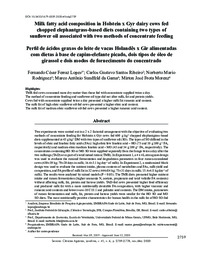Milk fatty acid composition in Holstein x Gyr dairy cows fed chopped elephantgrass-based diets containing two types of sunflower oil associated with two methods of concentrate feeding.
Milk fatty acid composition in Holstein x Gyr dairy cows fed chopped elephantgrass-based diets containing two types of sunflower oil associated with two methods of concentrate feeding.
Author(s): LOPES, F. C. F.; RIBEIRO, C. G. S.; RODRIGUEZ, N. M.; GAMA, M. A. S. da; MORENZ, M. J. F.
Summary: Two experiments were carried out in a 2 x 2 factorial arrangement with the objective of evaluating two methods of concentrate feeding for Holstein x Gyr cows fed 600 g kg-1 chopped elephantgrass-based diets supplemented at 45 g kg-1 DM with two types of sunflower oil (SO). The types of SO differed in the levels of oleic and linoleic fatty acids (FAs): high oleic/low linoleic acid ? HO (73 and 10 g 100 g-1 FA, respectively) and medium oleic/medium linoleic acid ? MO (43 and 34 g 100 g-1 FA, respectively). The concentrates containing HO SO or MO SO were supplied separately from the forage twice a day after the two milkings (TAD) or as part of a total mixed ration (TMR). In Experiment 1, a 4 x 4 Latin square design was used to evaluate the ruminal fermentation and degradation parameters in four rumen-cannulated cows (430±39 kg; 79±20 days in milk; 16.4±3.1 kg day-1 of milk). In Experiment 2, a randomized block design was used to evaluate the nutrient intake, plasma contents of metabolites and FAs, milk yield and composition, and FA profile of milk fat in 32 cows (444±84 kg; 75±31 days in milk; 15.4±4.8 kg day-1 of milk). The results were analyzed by mixed models (P < 0.05). The TMR diets promoted higher nutrient intake and rumen fermentation (higher ammonia N, acetate, propionate and total volatile FA contents) without affecting milk, fat, protein and lactose yields. TAD-fed cows presented higher feed efficiency and produced milk fat with a more nutritionally desirable FA composition, with higher vaccenic and rumenic acid contents and lower trans-10 C18:1 and palmitic acid contents. The DM intake, parameters of rumen fermentation and milk, fat, protein and lactose yields were similar for the HO SO and MO SO diets. The most nutritionally positive characteristics for human health in the milk fat of HO SO-fed cows were the higher eicosapentaenoic (+34%) and oleic acid (+11%) contents and lower palmitic acid content (-10%). Higher contents of vaccenic (+71%) and rumenic (+74%) acids and lower trans-10 C18:1 (-10%), elaidic (-32%), lauric (-14%) and myristic (-11%) acid contents were the most positive aspects of the milk fat of MO SO-fed cows. Considering the magnitudes of the differences in the levels of these FAs, it is concluded that the milk fat of cows fed MO SO showed a healthier milk FA profile.
Publication year: 2020
Types of publication: Journal article
Unit: Embrapa Dairy Cattle
Observation
Some of Embrapa's publications are published as ePub files. To read them, use or download one of the following free software options to your computer or mobile device. Android: Google Play Books; IOS: iBooks; Windows and Linux: Calibre.
Access other publications
Access the Agricultural Research Database (BDPA) to consult Embrapa's full library collection and records.
Visit Embrapa Bookstore to purchase books and other publications sold by Embrapa.

